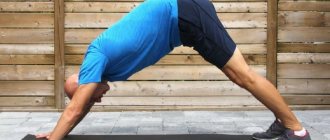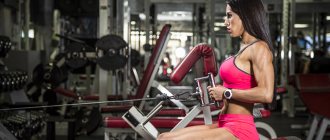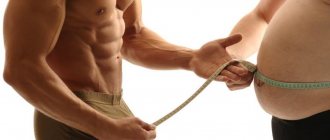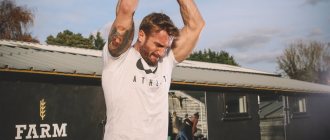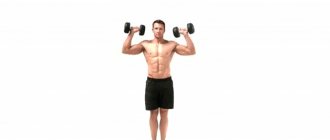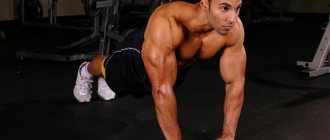Experienced bodybuilders use split programs. Trained athletes can no longer give a sufficiently intense load to all muscle groups in one session. As a rule, it is possible to qualitatively work out no more than 2-3 muscle groups at a time. Therefore, you have to split the training program into parts. As a result, each muscle group is worked out on a certain day of the week. The arm muscles are usually trained all together - in one day. The lesson plan may also include exercises for deltoids.
What is the secret of the three-day split: why is it useful and effective?
The main advantage that allows athletes (not just beginners) to get in shape and gain strength is the long time allocated for rest and recovery. That is, between training large muscle groups, there is a fairly long period of time - up to a week.
Experienced athletes can distribute the level of load independently, dividing training into levels: light, medium and heavy. This will allow the athlete to strengthen all absolutely large muscle groups, bringing the moment of their super compensation closer to the beginning of the next workout.
But you can’t train your chest the same way you train your legs. Having divided the workouts for the legs into heavy, medium and light, for the chest you need to choose only light and heavy loads. To achieve super concentration of all muscle groups, you need to be careful during exercise. It is also recommended to keep a training diary, in which you record on what day, which muscles were trained and what techniques were used. The diary will also help you track your achievements and, if necessary, make adjustments to the training process.
The training schedule is suitable for all athletes. This advantage has already been mentioned above, but now we are talking about the differences. During training, muscle mass increases, which takes a long time to recover. The principle is that larger muscles require more time.
The need for the recovery process is explained by the fact that the athlete plans an increasing load on the muscles with each training session, which is the only correct step for the body to begin to hypertrophy muscle mass. Otherwise, i.e. Under constant load, the human body considers it necessary to increase the volume of muscle tissue.
And in order for the weight of the bar to be increased each time, the athlete must conduct training precisely during the period of supercompensation. Please note: if the athlete manages to increase the load, then the scheme is working great! In principle, all schemes work if they are used correctly - at a certain time.
You need to think about changing the training process only when the existing training option does not bring growth to the athlete.
Detailed lesson program for the week
Training at home
Training day 1:
- Warm-up: cardio (jumping rope, running) – 15-20 minutes.
- Bent over weight row. Bend your legs slightly at the knees, and lower your body with a curved lumbar region to the bottom, taking additional weight in your hands (you can use water bottles instead of dumbbells). With your elbows pointing toward the top, slowly lift the weight until it touches your shoulder blades and return. Perform 3 sets of 12 reps.
- Pushups. Do a lying position. Next, lift your body by extending your arms and gradually return to the starting point. Do 3 sets of 10 push-ups.
- One arm row. While standing, bend one leg and lean against a chair/chair, place the same arm on a flat surface. The weight should be in the opposite hand. Begin to smoothly pull your arm with the weight up until peak muscle contraction and return. Perform 3 sets of 8 reps.
Training day 2:
- Warm-up: cardio (jumping rope, running) – 15-20 minutes.
- Shrugs with weights. Stand up straight and take extra weight in your hands. Slowly lift the weight at the top, as if trying to connect your shoulders at the back of your head. Then return to the starting point. Do 3 sets of 12 repetitions. Start with heavier weights on the first set and finish with lighter weights.
- Push ups. Do a classic hands-on position while lying down. Raise your body by straightening your arms and then return to the starting point. Perform 3 sets of 10 reps.
- Alternate raising of arms. Stand up straight and take weights in your hands. Alternately, bend your elbow and raise your hand to chin level, then lower it. Do 3 sets of 8 reps for each arm.
How should small muscle groups be trained?
Classes should be organized twice a week, in contrast to training a large muscle group, which is enough to load once a week. This distribution during a split results from a specific grouping of muscle tissue. After all, when an athlete trains the pectoral muscles, the load also applies to the triceps, and when the back receives it, the biceps are also trained. In the process of training large muscle groups, the biceps and triceps receive superficial load, which creates the prerequisites for their micro-periodization. It is especially important to understand this for beginners, who cannot yet correctly distribute the load across all muscle groups, but simply change the degree of load, thereby throwing off the training plan. As a result, the result is slowly achieved (if achieved) and faith in the athlete’s success is lost.
The disadvantages of such training include that:
- they do not provide the necessary specialization.
This disadvantage is explained by the reduced number of classes, as a result of which it is difficult for the athlete to allocate time for training a specific muscle group. It has been proven that only when all the athlete’s efforts throughout the entire training are directed to a specific muscle group will they respond and work better. This is directly related to the limited functioning of the human endocrine system. Since the body primarily restores large muscle groups, it is recommended to simultaneously train the shoulders and legs, which represent the large and small muscle groups. When training the legs with biceps, the strength may run out even before the athlete needs to move on to training a small muscle group. If this happens, it is recommended to postpone training for a day or more.
- not enough space for deadlifts
Back muscle training is divided into two parts: training long muscles and broad muscles. If you train these muscles at the same time, you may not see results at all. The only correct way would be a joint workout, at the end of which a deadlift is done - the hardest type of exercise (but also the most effective!) for the joints. If you start training with a load on the long muscles, you may not have enough strength for the broad muscles, which, due to the quickly tired long muscles, will receive a greater load. It is advisable to carve out a separate day for such a difficult workout.
Exercises for the brachialis muscle
Many athletes ignore or are unaware of the brachialis muscle. And its development is needed for a more massive and impressive appearance of biceps and triceps. The biceps muscle takes up less space than the triceps and brachialis. Together with the biceps, the brachialis crosses the elbow joint and is involved in adducting the forearm to the shoulder, bending the arm at the elbow. It is located deep in the shoulder muscles, attached to the shoulder bone at one end and connected to the forearm on the other side. It does not participate in supination, but flexes the elbow joint.
When the arm is flexed (thumb pointing upward), the load is placed more on the brachialis rather than the biceps. If there is an imbalance between the development of the biceps and brachialis, then pain in the elbow joint may occur, limiting movement when pumping up the biceps.
In exercises for the brachialis, you can use hammer, reverse and spider grips, as well as overhead curls using the anatomical features of the position of the biceps: the closer they are to the head, the greater the load on the brachialis.
Exercises:
- lifting the barbell onto the biceps using a reverse grip;
- lifting dumbbells using a hammer grip;
- on the Scott bench, barbell curls;
- spider curls - bending the arms with the elbows resting.
Exercise program for phase No. 1
Exercises:
- No. 1. Cross your arms in a hammer style with dumbbells. First, warm-up exercises are performed for 10 repetitions - 2-3 approaches, then working exercises - 10 repetitions and 3 approaches.
Remember! Each muscle contraction requires a strong squeeze of the dumbbells. When lowering the dumbbells, you should fully extend your arms to warm up your lower biceps.
- No. 2. Bend your arms on a Scott bench using a barbell with a curved bar - 8 reps and 3 sets. The bar is lowered without fully straightening the arms (by 90%) to prevent injury.
- No. 3. Bend your arms in a standing position, using a straight barbell or with a curved bar, pause - 3 seconds, repetitions - 8, approaches - 2. The weight is lowered after the pause, and you can feel the muscles “burning”.
- No. 4. Extend the arms to the triceps using the torso (vertical block). Elbows pressed to the body, muscles tense at the lowest point for 1 second, repetitions - 12, approaches - 4.
- No. 5. Push-ups in a machine or on parallel bars with increasing weight in each approach. Repeat 8-12 times, 3 approaches.
- No. 6. Use a curved bar for extensions on an incline bench, repetitions - 15, approaches - 3. The weight should be lowered lower behind the head. It is not recommended to use heavy weights.
Exercise program for phase No. 2
Exercises are performed with a 45-second break:
- No. 1. The arms are bent with a reverse grip, using a straight or curved bar. Reps - 10, sets - 5, break between sets - 10 seconds.
- No. 2. The arms are extended to the triceps using a cable. Repetitions - 10, sets - 5. Warm-up exercises are performed first. The break between approaches is 10 seconds.
- No. 3. Arms are bent on a Scott bench or on a machine. Reps - 12, sets - 3. The biceps are loaded, 6 repetitions are performed independently, 6 - with the help of a partner.
- No. 4. Presses in the triceps machine. At first, do 8 heavy reps and 3 sets. There is a 3 second delay before the weight is slowly lowered. On the 4th set, the weight is set for 6 heavy negative reps.
- No. 5. Concentrately bend your arms with dumbbells using an incline bench. Reps - 8, approaches - 2.
- No. 6. Perform L-extensions for each arm. Reps - 15, sets - 4.
- No. 7. While sitting, bend your arms with dumbbells, pause - 3 seconds, repetitions - 8, approaches - 2.
- No. 8. Using a narrow grip, do the EZ-bar press, reps - 8, sets - 4. The weight is lowered slowly towards the chin, without holding it on the chest.
Conclusion. By adding variety to your workouts, you can achieve an increase in muscle mass (biceps and triceps) by 1-1.2 kg per month without the use of proteins or other drugs.
Today, most experienced bodybuilding athletes prefer to train using split programs. After several years of training, athletes can no longer fully work out all muscle groups in one or two workouts; they decide to split different muscle groups on different days of the week. Most often, 2 or 3 muscle groups are worked out in one session, since the more muscles we use during training, the greater the release of anabolic hormones will be. Today we will talk about joint training of the deltoid muscles and arms (biceps and triceps), consider the training program and effective exercises.
This type of load can be replaced in several ways.
First way
Leaving the load on the shoulders and legs, the athlete can combine it in this type of training with training the muscles of the back and biceps, chest and triceps. That is, purposefully work only with a large muscle group, leaving special isolation exercises for small muscle groups performed at the end of the workout. The advantage of this method is that the main force will be directed to large muscle groups, which will allow the total muscle mass to develop faster and increase in volume. In this case, little attention is paid to the hands, which, undoubtedly, is a disadvantage of this method.
Second way
The main emphasis here is on arm training. During training, the athlete trains his legs and chest, back and shoulders together, leaving one day for training exclusively his arms. As a result of such exercises, the upper body and, as a result, the endocrine system are effectively strengthened. It will be possible to develop and progress much faster using this method. By paying a lot of attention to arm exercises, they gain decent muscle mass and allow them to move on to further development. The disadvantage now is that the leg muscles are practically not used.
The third method is joint exercises for the following muscles: shoulders and chest, legs and biceps, back and triceps. The best results are obtained by training in a lying position. The shoulders, however, are sacrificed in this case. If the emphasis is on the legs, then the biceps are immobilized. At the same time, such exercises allow you to spend a lot of time on your legs and keep your biceps in good shape, which helps to fully restore the delta for the next workout aimed at the chest. When it comes to the legs and shoulders, the athlete's development in the bench press may be slightly hindered by the anterior deltoid. The scheme is good for those who want to strengthen their pectoral muscles and pump up their legs.
Joint training of deltoids and arms: a set of exercises
When combining the muscles of the shoulder girdle and arms within one lesson, the deltoids are trained first, followed by the biceps and triceps. The first exercise plan is usually the military press, which focuses the load on the middle and front deltoids. In addition to the deltas, this exercise also actively works the triceps muscles of the shoulder. The military press is followed by a seated dumbbell press, which targets all three bundles of the target muscle. By pulling the barbell to your chin with a wide grip, you can pump up the middle and rear deltoids. Bent over swings help to “finish off” the back beams, and side lifts of dumbbells help the middle ones.
The biceps brachii muscle can be pumped up by doing close-grip pull-ups on the bar. Another effective biceps exercise is lifting a barbell in front of you (arm curl). Hammer curls can be used as an auxiliary exercise. The narrow bench press and French press are ideal choices for developing triceps.
Each movement from this set of exercises must be repeated 8-12 times (pull-ups to the bar 8-10 times). A series of 8-12 repetitions constitutes one set. There should be 3-4 such sets in total. Rest between sets lasts 30-40 seconds. Since muscles tend to adapt to the same type of impact over time, the proposed set of exercises must be periodically updated and adjusted.
Recommendations
If you systematically use this three-day split scheme , the goal of which is to increase muscle mass through intense physical activity, you can achieve good results quickly. But in order not to lose it later, you need to continue intensive training. Otherwise, the body may start burning muscle fibers.
For even faster and better muscle mass gain, you need to adhere to a diet for bodybuilders, which is aimed at creating an excess of calories - the main sources of anabolism. To quickly gain muscle mass, it is very important to have an excess of nutrients that are actively involved in the formation of new muscle tissue, and regular physical activity. Without them, neither regular nutrition nor taking vitamins and proteins will lead to the desired result.
The success of training depends on a well-organized training system, a correctly chosen load and rest regime, during which strength is restored. Therefore, it is recommended to often use basic exercises for a basic split, and add isolating exercises to them later, when the basic ones are no longer enough to gain muscle mass.
The minimum rest time between approaches is up to a minute. Exercising at this pace well stimulates hypertrophy of muscle tissue.
You need to know that bodybuilders' training is extensive and long. On average they last 40-50 minutes, so there is little time left for rest.
Three-day split training scheme (standard approach)
Exercises for biceps and triceps
- Standing biceps curl. Exercises, being basic, are included in almost every athlete’s training program. Lifting the barbell gives the necessary load on all areas of the biceps.
- Biceps curl with supination. There is a lot of debate about how useful and effective this style is, but just walk into any room and all questions will disappear. Exercises for biceps and triceps are always recommended to be performed with supination.
- Lifting the barbell on a Scott bench. The exercises are often performed with an EZ barbell and are aimed at the lower part of the biceps. When using a regular bar, your hands, wrists and forearms quickly become tired and begin to ache. Biceps and triceps are often pumped up in one day thanks to the EZ barbell.
- Hammer style dumbbell raises. When performing this exercise, you should use a grip in which your palms face each other. The main load will go to the outer part of the biceps.
- Barbell press with a narrow grip. This exercise is basic for working the triceps. It is important to learn how to correctly follow the technique in this exercise - if it is not followed, the load is equally divided between the triceps, pectoral and deltoids muscles. Pumping up your biceps and triceps is extremely important.
- French press. A great exercise that targets the long triceps without putting stress on the deltoids and chest. Starting position – lying on a horizontal bench. An EZ bar must be used. Biceps and triceps in the video are often pumped with this barbell.
- Arm extensions on a vertical block. This exercise involves all areas of the triceps and is basic.
The biceps and triceps get a lot of workload on the same day, so they need a lot of rest time. When training these groups, the maximum rest between sets should be about 45 seconds.

